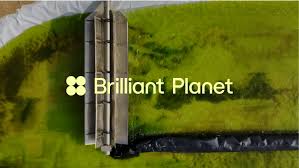
© 2025 Made for Planet • Privacy Policy • Terms & Conditions
Platform by Mission Sustainability
All categories Carbon emission control Brilliant Planet


London, London, United Kingdom
Brilliant Planet is unlocking the power of algae as an affordable method of permanently and quantifiably sequestering carbon at the gigaton scale. The company’s innovative process enables vast quantities of microalgae to grow in open-air pond-based systems on costal desert land. This is achieved without using fresh water, by harnessing a natural process that contributes to the health of oceans and air.
Raffael Jovine
Founder & Chief Scientist
Operating since 2013
Eco-system
Oceans
Deserts
Sectors
Ocean Conservation
Climate Change Mitigation
Carbon Offsetting
Industrial Efficiency
Method and technique
Brilliant Planet uses Marine algae to sequester the CO2. Algae are highly efficient at photosynthesis; the process that biological organisms use to absorb and convert CO2 into biomass. Beneficial coastal algae blooms are responsible for 20% of the global carbon cycle (more than all forests combined) and 10-50x more efficient at CO2 fixation than terrestrial plants per unit area. This makes them an inherently effective option for CO2 sequestration. Brilliant Planet's approach combines the affordability of nature-based systems with the durability and measurability of engineered systems. . An algal starter monoculture is grown in the lab. After 10 days in the lab, the blooming algae are transferred into a greenhouse. After the greenhouse they move the organisms into outdoor ponds, where they spend the remaining five days growing rapidly in the large outdoor production ponds. The algae are filtered out of the final pond by passing the water through screens. These retain a concentrated biomass 'slurry' whilst allowing filtered seawater to pass through. The filtered water that returns to the shallow ocean surface is de-acidified and promotes biodiversity restoration. Then pump the biomass slurry produced at harvest up a drying tower, which sprays the mixture into the hot, dry desert air. The particles rapidly dry as they float back to the ground and take the form of a dry, salty powder. The dried algae is collected, weighed, and put into specially lined landfill sites located above future sea level projections. It remains highly stable over time because it has a high salt content and other physical properties that prevent degradation. The buried composite is dry and has low water activity, which inhibits degradation. It is also extremely salty and naturally acidic. Long-term storage has been shown by naturally preserved biomass that has remained stable for thousands of years under similar conditions. This means it can be permanently stored in simple desert landfills.
Found any error in information about this organisation?
Are you owner of Brilliant Planet?
Similar companies

CarbonTrail Limited
Canterbury, New Zealand
Carbon Trail provides a platform to measure, manage, and reduce carbon footprints. With user-friendly tools and actionable insights, it helps businesses and individuals understand their environmental impact, comply with regulations, and implement sustainable practices. The platform also fosters a community focused on sustainability and environmental responsibility.
Seabound
Seabound is at the forefront of sustainable maritime technology, offering innovative carbon capture solutions tailored for ocean vessels. Their cutting-edge technology is specifically designed to be installed on ships, capable of capturing up to 95% of CO2 emissions. This pioneering approach addresses the urgent need for reducing greenhouse gas emissions in the maritime industry, aligning with stringent global regulations and the growing demand for eco-conscious practices. Seabound's solution not only helps shipowners meet environmental targets but also satisfies the expectations of customers and stakeholders prioritizing sustainability. By providing a proven and efficient method to mitigate carbon footprint at sea, Seabound is driving positive change towards a cleaner and greener future for the shipping industry.

Toitū Envirocare
Toitū Envirocare provides comprehensive carbon and environmental certification programs for businesses. Their services include carbon footprint measurement, emission reduction strategies, and sustainability certifications. By using science-based tools and actions, Toitū helps companies achieve significant environmental progress and meet regulatory requirements, fostering a collective effort towards a sustainable future.

Carbonhound
Toronto, Ontario, Canada
CarbonHound emerges as a transformative force in the realm of environmental responsibility, offering a comprehensive platform that empowers businesses and individuals to take meaningful action against climate change. Through sophisticated data analysis and actionable insights, they provide a clear understanding of carbon footprints, enabling informed decisions for emissions reduction. By facilitating sustainable practices and advocating for responsible choices, CarbonHound actively contributes to a more sustainable future.

Ekos
New Zealand
"Ekos is a leading provider of carbon management software and services in New Zealand. They empower businesses to measure, manage, and offset their carbon footprints through innovative tools and solutions. Ekos supports sustainability efforts by enabling organizations to track emissions and invest in impactful carbon offset projects."